Hounds of the Baskerville (sic)
A Brief Historical Summary
Donald J. Terras B.S.I
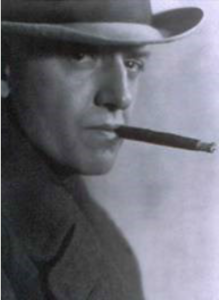
Vincent Starrett, 1948.
Photo by Don Loring
The Hounds of the Baskerville (sic) was founded by Charles Vincent Emerson Starrett in 1943. Starrett (1886-1974) was born in Toronto but moved to Chicago in 1896, made it his home, and began his writing career as a newspaper journalist for the Chicago Inter-Ocean in 1906. After only a year, he moved to the Chicago Daily News where he covered the crime scene and was also a feature writer, political analyst, and war correspondent. Starrett’s assignments during this time brought him into contact with other reporters including Eugene Field, Carl Sandberg, Jack London, Ben Hecht, and others who would hone their writing skills and, like Starrett, become prominent authors. In addition to his newspaper work, Starrett wrote and edited more than 50 books that include essays, criticism, fiction, biography, poetry, and bibliography. But he was most recognizable to the general public through his “Books Alive” column in the Chicago Tribune, a feature of the newspaper for more than 25 years until Starrett retired in 1967.
Starrett’s adventure into Sherlock Holmes began during a trip back to Toronto at an early age. While visiting his grandfather’s bookstore, he found a volume of short stories that contained Arthur Conan Doyle’s Sherlock Holmes tale “The Adventure of the Speckled Band.” After reading it, he became a dedicated Sherlockian for the rest of his life and even got the chance to interview Conan Doyle in 1912. According to Mangler (2001), Starrett wanted to talk about Sherlock Holmes and Doyle wanted to talk about Spiritualism. They compromised – half and half.
The fire and passion that developed in Toronto began to blaze in Chicago with Starrett’s The Adventure of the Unique Hamlet (1920), his first Holmesian book and a Sherlock Holmes pastiche. This publication gave him national recognition and brought Starrett into contact with other like-minded souls during the period before Sherlockians became organized into distinct literary circles. His 1933 book, The Private Life of Sherlock Holmes, is deemed a classic by Sherlockian scholars and his 1942 sonnet, 221B, is a literary staple of all Sherlockians. Starrett’s leadership role was instrumental in helping to forge the movement that led to the establishment of groups whose mission was to promote greater awareness of the Sherlock Holmes canon and expand the world of Conan Doyle’s, and literature’s, most famous character.
Outside of Starrett’s Sherlockian interests and role in founding The Hounds of the Baskerville (sic), he can be seen as a remarkable 20th-century literary figure and, indeed, carried well his self-given moniker as “the last bookman.” Those seeking a more well-rounded biography of the man should look to Vincent Starrett – Chicago Man of Letters by former Master of the Hounds, Robert Mangler, at the end of this brief Hounds history or Starrett’s own autobiography, Born in a Bookshop (U. of Oklahoma Press, 1965).

Charles Collins.
From Nieminski, 1983
News of Starrett’s intent to form what would become The Hounds of the Baskerville (sic) goes back to 1942 and a notice in the November 22nd Chicago Tribune that “A Chicago chapter of the Baker Street Irregulars is planned by Vincent Starrett.” While Starrett was spearheading creation of such a group he did have support and help, most notably from his long-time friend and colleague at the Tribune, Charles Collins (1880-1964). Collins, a fellow Sherlockian, edited the Tribune’s “Line 0’ Type or Two” column from 1938 to 1951 in which the Hounds were frequently mentioned after their establishment. John Nieminski, in his History of the Hounds (1983), refers to Starrett being “wangled by berth” to the Tribune by Collins, who actually may have motivated Starrett to organize the Hounds. With the two working in such close proximity, “it is probably no coincidence that the Hounds bonded onto the scene so soon thereafter.” There was also help and inspiration from Stanley Pargellis (1898-1968), Librarian for Chicago’s Newberry Library, and Horace J. Bridges (1880-1955), head of the Chicago Ethical Culture Society.
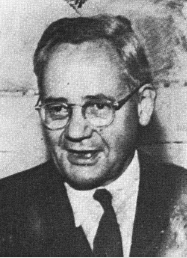
Stanley Pargellis.
From Nieminski, 1983
The first announcement of a Sherlockian group in Chicago – an affiliate of the Baker Street Irregulars in New York founded in 1934 – was published in the Chicago Tribune’s “Bookman’s Holiday” column on November 22, 1942 and read:
A Chicago chapter of the Baker Street Irregulars (Sherlock Holmes worshippers who hold annual dinners in New York) is planned by Vincent Starrett. The neophytes will be instructed that the society’s first rule is to never mention, at its meetings, the name of A. Conan Doyle. “He killed Sherlock, say the Irregulars, and we can never forgive him.”
On January 9, 1943, Collins reported further in his “Line 0’ Type or Two” column that he had visited Starrett the night of January 8th for the reason of “founding an esoteric circle, of which more anon.” True to his word, more was revealed about this meeting in his column on January 12th: Foregathered [on January 8] with three adepts in the recorded adventures of Sherlock Holmes, the great detective, for the purposes of founding an esoteric circle to study his cases, and perpetuate his fame, and observe his birthday with a feast.
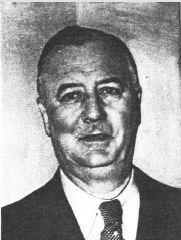
Horace Bridges.
From Nieminski, 1983
We exchanged greetings by telegraph with a similar circle in New York, called the Baker Street Irregulars, then holding their annual banquet. We came to no decisions about a name for our group, but I intend to vote for the Hounds of the Baskervilles. All such matters, however, must be approved by the mastermind behind our movement, a mysterious character. Anyhow, the game’s afoot…
Starrett later described that meeting in a letter to his friend and fellow collector, Esther Longfellow, dated January 19. 1943, writing:
We have founded a chapter of the Baker Street Irregulars here in Chicago, the founding meeting occurred at my apartment on the evening of the 8th, while the annual BSI brawl was going on in New York. Suitable telegrams were exchanged between the celebrating groups. Morley’s to me, was refused by the Western Union as unnecessary and hilarious; I should like to have seen the original, which had to be cut down to an innocuous greeting. There is a division of opinion among the Chicago Irregulars as to the name for our group. Are we the Red Circle (political connotations here are unfortunate), the Red-Headed League, the Dancing Men, the Tired Captains, or the Hounds of the Baskerville (no S), Altamont Chapter, or Wisteria Lodge? What do you think? Or have you a better name than any of these?
The authoritative report of this January 8th meeting was written by Starrett and published in the Baker Street Journal (OS), Vol. 1, No. 2:
The Chicago chapter of the Baker Street Irregulars was founded in January 1943, without a name and with only four charter members. The four, who still greet one another with a shocking gesture of cut-throat affection, were Vincent Starrett, an obscure man of letters specializing in the Watson formula; Charles Collins, columnist of the Chicago Daily Tribune; Stanley Pargellis, librarian of the Newberry Library; and Horace J. Bridges, head of the Chicago Ethical Culture Society. Its present name, the Hounds of the Baskerville (sic), is a happy permutation later suggested by Dr. Pargellis, after fourteen earlier suggestions had been voted down. The group has had only one officer from the beginning, Mr. Starrett, who is known as The Needle. Most of the actual work of the organization, however, is done by Mr. Collins, whose daily column is a sort of clearinghouse for Sherlockian notes and queries, including all vital information about the exploits of the local chapter.
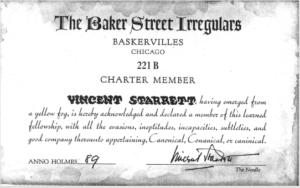
Following in the footsteps of The Baker Street Irregulars, the Hounds joined the ranks of The Five Orange Pips in New York City (1935) and the Speckled Band of Boston (1940), in keeping green the memory of Sir Arthur Conan Doyle’s famous consulting detective. It is interesting, however, to note that The Five Orange Pips formed apart from the Irregulars, whereas the Speckled Band and Hounds were formed as scions, or offshoots, of the BSI. A few short months after establishment of the Hounds, Starrett began to give consideration to the group’s identity and composition, and he laid out some of his thoughts in this April 29, 1943 letter penned to an aspiring Sherlockian, Clifton R. Andrew of Akron, Ohio:
Recently I formed a Chicago chapter, although not much activity has yet developed. There is a very active branch in Boston called the Speckled Band. My own feeling is that letting in just anybody who happens to think he likes Sherlock Holmes, or has seen Basil Rathbone in the motion-pictures, is a mistake. You will get more fun out of it if you will bring together a small group of genuine enthusiasts, any and all of whom are at least capable of contributing something to Sherlockian scholarship – whether or not they actually do. That way your discussions, anyway, will be intelligent and stimulating. Don’t meet too often. The Bostonians, who are fairly mad, try to meet once a month; but the NY outfit meets once a year for a big dinner – unless a few of the members care to get together now and then for luncheon and talk; but that’s their own lookout.
In fact, Starrett played a prominent role in the formation of the Baker Street Irregulars, and his stature among the New York group was such that he received their very first Investiture in 1944 as “A Study in Scarlet,” noting Starrett’s “devotion, affection, and scholarship over the years in unparalleled measure and beyond the call of duty.” The friendship between the two notwithstanding, Starrett attended only the BSI’s first annual dinner (December 7, 1934), and Morley never did make it to Chicago for a Baskerville carousal.
“On the Trail of Sherlock” was the title of Collins’ “Line o’ Type” column of December 13, 1943, that preceeded the next Hounds dinner meeting. It read:
The Baskervilles, an esoteric circle of Sherlockholmesians (pronounced Holmeezians), will at their next meeting, in a private room in Chicago’s most secluded literary cafe, give careful consideration to the recent remarks of A. Conan Doyle’s son, to wit: “My father himself was the original of Sherlock Holmes.” This is heresy of the first degree to the Baskervilles, who hold firmly to the opinion that Doyle killed Sherlock Holmes and, but for his later penitence and miracle of resurrection, should have been dealt with under the strictest procedure of British justice. The Baskervilles, in passing sentence upon his son, Adrian, will probably knock off a few years if the defense enters a plea of filial piety…
The date of this first official meeting was January 7, 1944, and it was held at Schlogl’s Restaurant at Madison and Wells Streets in Chicago’s Loop – a famous haunt of newspaper journalist circles during the mid-twentieth century. Starrett noted in a memoir published in the Baker Street Journal in 1944 that the Hounds numbered an even dozen enthusiasts in attendance, among them W.H. Galliene, British Consul-General in Chicago; Dr. Irving S. Cutter, syndicated physician; Leonarde Keeler, inventor of the “lie detector”, Lowell D. Ryan of the FBI; Lt. Corn; Carl S. Brick, USNR; and Ben Abramson, bookseller.
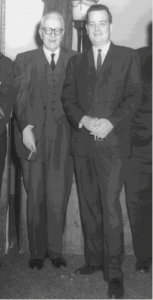
Vincent Starrett seen here with Robert J. Mangler at Sages Restaurant in 1964
By January 1945 the Baskervilles had increased their number threefold and had developed a good deal of Sherlockian punch, particularly in the form of Jay Finley Christ, Professor of Business Law at the University of Chicago, and described as “one of the most scholarly of Starrett’s band of Holmesian acolytes.” (Nieminski, 1983) Like the Baker Street Irregulars, membership in the Hounds has always been by invitation only, although the group originally had its annual meetings in January, it changed the date in 1946 to late September or early October noting that it was the season of Michaelmas when the case of The Hound of the Baskervilles was brought to the attention of Sherlock Holmes.
There were few interruptions to this schedule until the Great Hiatus of 1957-59, caused by the death and relocation of some key members including Robert J. Bayer who died in 1956 immediately before The Great Hiatus. Bayer had handled all of the Hounds business matters and was in all respects performing as Master of the Hounds. Chicago’s Sherlockian scene was depressed until 1960, when Vincent Starrett wrote in his Tribune “Books Alive: column that “Sherlockian activities in Chicago, stagnant for some years, are to be resumed with enthusiasm in 1960, I am informed.” In fact, it was attorney Robert J. Mangler, recently discharged from the Navy, who single-handedly resuscitated the Sherlockian scene in the Windy City at a May 19th meeting of both The Hounds and Hugo’s Companions, a Chicago scion formed in 1949 by Hound, Matthew Fairlie. John Nieminski attended the meeting and said of Mr. Mangler’s “peroration” on that occasion that it “rivaled in its intensity William Jennings Bryan’s famed ‘Cross of Gold’ speech, stampeded the rumpees, and instantly elevated him to a position of permanent prominence among the movers and shakers, and the Great Revival Meeting followed a few weeks thereafter.” Some months later, the October 1960 Baker Street Journal reported that “On My 19, in typical London weather, 24 Hounds, Companions, and neophyte Irregulars gathered at Baskerville Hall to answer the question: What became of the Baker Street Irregulars in Chicago?”
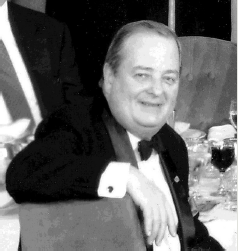
Robert J. Mangler, 1983
While Vincent Starrett remained the dean and doyen of all things Sherlockian, and founder of the Hounds, under his baton Mangler became the first officially anointed Master of the Hounds in 1964, a position he would keep for forty years. In 1964, Mangler also received his Investiture from the Baker Street Irregulars as “Sir Hugo Baskerville.” In fact, Mangler not only rose to the upper ranks of the Sherlockian world, but he would see his legal opportunities prosper, and for 27 years he held the position of Corporation Counsel for the Village of Wilmette, a suburb of Chicago’s North Shore. He also served as president of the International Municipal Lawyers Association for several years.
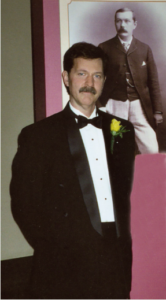
Donald J. Terras during A Doyle Family Dinner at the Newberry Library in 2003. Photo by Ann Kittle
During his long tenure with the Hounds, Mangler would see the Chicago Sherlockian community grow from two scion societies of the Baker Street Irregulars to more than nine. But his focus was always on the Hounds, and he held them on a short leash until 2005 when failing health made it necessary to turn over his position. He chose Donald J. Terras of Evanston, IL, as his successor. In Terras’ words, “Bob was recuperating after surgery in a rehabilitation center not far from my residence. It was his birthday, so I went to visit and was more or less told I would be succeeding him as head of the pack. There really wasn’t very much discussion about the matter.”
Don Terras had been introduced to the Chicago Sherlockian scene in 1985 by Ely Liebow, A colleague at Northeastern Illinois University and nationally known Holmesian authority. Terras made his way up through the officer ranks to serve as president of Hugo’s Companions (est. 1949) and also served a term as president of The Criterion Bar Association (est. 1968) both Chicago Sherlockian scions. He was president of the Companions while presiding over their 50th anniversary festivities and served as project manager and contributing editor of Hugo’s Companions: The first Fifty Years of a Sherlockian Scion Society (Windy City Press, 1999). In 2003, he helped plan and served as chairman for “A Doyle Family Dinner” at Chicago’s Newberry Library, celebrating the establishment of the Newberry’s C. Fred Kittle Collection of Doyleana. To help commemorate the event, Terras, Senior Lecturer of Anthropology at Northeastern Illinois University, arranged for the school to publish a limited edition book, Sir Arthur Conan Doyle and Sherlock Holmes (NEIU Press, 2003).
At the Hounds of the Baskerville(sic) dinner on Oct. 7, 2005, Terras was welcomed as successor to Robert J. Mangler, Master of the Hounds for forty years. That same night, he was also inducted into the ranks of the Baker Street Irregulars. Recognizing that Terras’ work includes management of a local unit of government while residing in a lighthouse, he was given the investiture of The Politician, the Lighthouse, and the Trained Cormorant which is an undocumented account alluded to in Conan Doyle’s Sherlock Holmes canon. Noting that he had actually been given three investitures, his personal preference was to simply use …The Lighthouse.
From 2005 to 2020 Terras led the Hounds, opening up the membership to women and increasing the group’s membership base so that by 2019 a large percentage of members from across the country attended the annual dinner meeting. In 2005, the Hounds launched their first web site that would eventually be re-designed by webmaster, Monica Schmidt. At the same time, ace researcher, Julie McKuras volunteered to help update the biographical section on the web site. Both were new members of the Hounds and through their work gave the website a more upscale look and depth in terms of the group’s history. Within two years, over 76% of the membership dating back to 1943 had a biography. In recognition of the increased use of social media, Terras came to enlist the aid of another Hound, Al Shaw, to start and manage a Facebook page for the group. In 2017 the Hounds produced a 75th anniversary limited edition book, The History of the Hounds of the Baskerville (sic), reprinting the late John Nieminski’s forty-year history and taking it into 2017 with Terras as co-author. The following year saw restoration of Vincent Starrett’s headstone in Graceland Cemetery. This initiative was led by Laura Page with help from Don Terras and the Hounds and greater Sherlockian community who made donations to the project. Originally installed in 1986 as a fitting tribute to The Needle, this two-year project was completed in 2018 and announced by Master Terras at the group’s annual dinner on September 28 of that year.
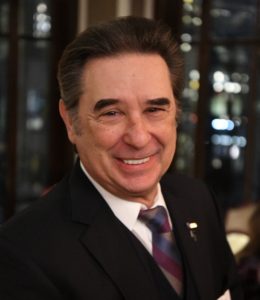
Al Shaw, BSI
From the 2020 BSI Dinner
Photo by Will Walsh, BSI
In January of 2020, citing increasing personal and professional obligations, Terras retired as Master of the Hounds and turned the group over to fellow Hound, Alan (Al) Shaw. At the time, Al was “Sir Hugo,” the president of Hugo’s Companions but his Sherlockian roots go back to his native New York. He had always enjoyed the Sherlock Holmes stories but when his brother, Mike, started corresponding from Africa using the Dancing Men cypher for privacy his appreciation deepened. Upon rereading all the stories, Al’s interest in Holmes was codified. He moved to Chicago in 1969 and became a member of Hugo’s Companions in 1971 where he served as an officer and wrote his first Sherlockian article, published in Baker Street Miscellanea. Al was present at the first meeting (and then a member) of The Criterion Bar Association in 1972 and was inducted into the The Hounds of the Baskervilles (sic) in 1982. It was a golden age for Sherlockians in the Windy City and with the Companions and Hounds Al was befriended by such luminaries as Vincent Starrett, John Bennet Shaw, John Nieminski, Ely Liebow, Don Pollock, Fred Levin, Bob Mangler, Paul Smedegaard, Bill Goodrich, and Dave Stevens to name a few. Several years later a work-related move took Al to California and the start of his Great Hiatus. He returned to Chicago in 2005, however, and for the last fifteen years has been a permanent fixture in the Sherlockian community, active in multiple scions and Sherlockian activities and contributing to periodicals and anthologies. In 2018, he received the investiture of “Sir Hugo Baskerville” from The Baker Street Irregulars, the same investiture formerly held by Master of the Hounds, Robert J. Mangler.
To the present day The Hounds enjoy a respected patriarchal status in the Sherlockian world, which includes well over 300 recognized scion societies in the U.S. and over 400 worldwide. The Hounds anchor Sherlockian activities in Chicago, the foundation from which many other local scion societies have sprung, making the Windy City one of the most active centers for the appreciation and study of the Sherlock Holmes canon and written work of Sir Arthur Conan Doyle.
References
Lellenberg, Jon, Editor
Disjecta Membra: Stray Scraps of Irregular History, 1932-1950
Mangler, Robert J.
Vincent Starrett – Chicago man of letters
The Caxtonian, May, 2001
http://www.caxtonclub.org/reading/2001/May2001/starrett.htm
Nieminski, John
The Hounds of the Baskerville (sic) 1943-1983
Valuable Institution Press, 1983
Terras, Donald
Hugo’s Companions
Windy City Press, 1999
Link
BSI Archival History
http://www.bsiarchivalhistory.org/
Northern Illinois University Vincent Starrett Collection
http://www.ulib.niu.edu/rarebooks/vincentstarrett.cfm
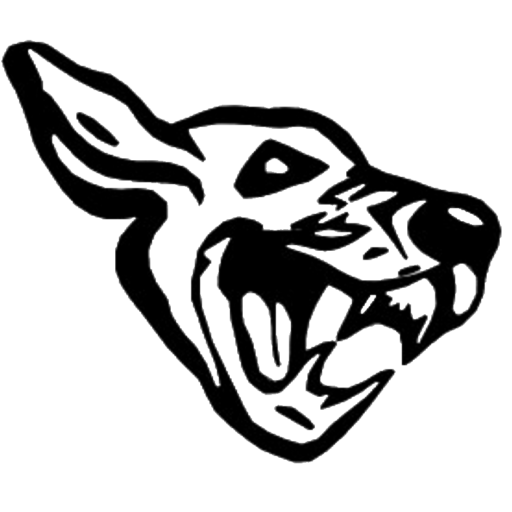
19 thoughts on “History”
Comments are closed.